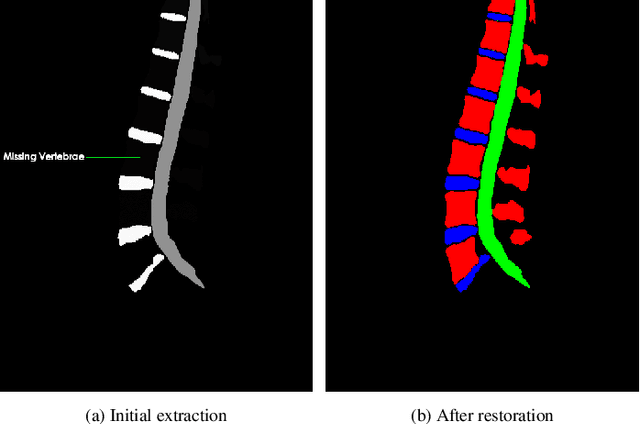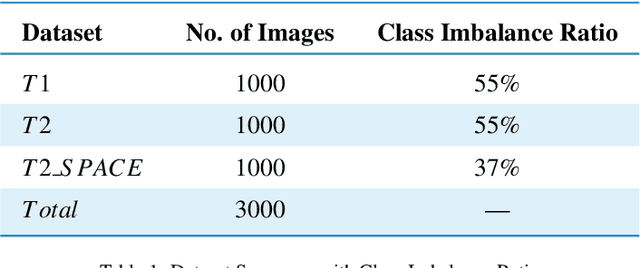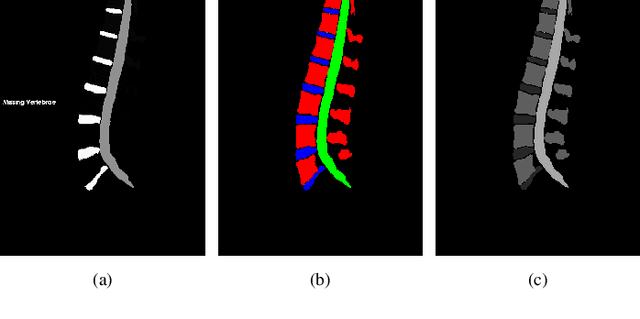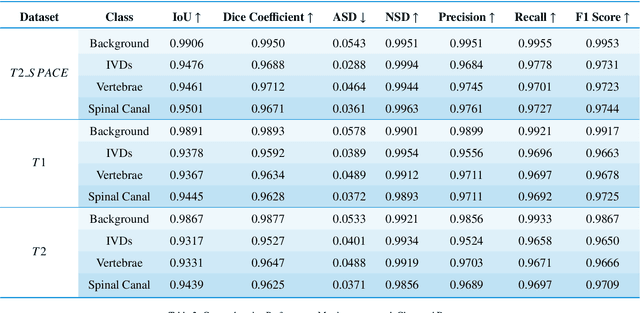Md. Shakib Shahariar Junayed
Pioneering Precision in Lumbar Spine MRI Segmentation with Advanced Deep Learning and Data Enhancement
Sep 09, 2024



Abstract:This study presents an advanced approach to lumbar spine segmentation using deep learning techniques, focusing on addressing key challenges such as class imbalance and data preprocessing. Magnetic resonance imaging (MRI) scans of patients with low back pain are meticulously preprocessed to accurately represent three critical classes: vertebrae, spinal canal, and intervertebral discs (IVDs). By rectifying class inconsistencies in the data preprocessing stage, the fidelity of the training data is ensured. The modified U-Net model incorporates innovative architectural enhancements, including an upsample block with leaky Rectified Linear Units (ReLU) and Glorot uniform initializer, to mitigate common issues such as the dying ReLU problem and improve stability during training. Introducing a custom combined loss function effectively tackles class imbalance, significantly improving segmentation accuracy. Evaluation using a comprehensive suite of metrics showcases the superior performance of this approach, outperforming existing methods and advancing the current techniques in lumbar spine segmentation. These findings hold significant advancements for enhanced lumbar spine MRI and segmentation diagnostic accuracy.
Optimizing Universal Lesion Segmentation: State Space Model-Guided Hierarchical Networks with Feature Importance Adjustment
Apr 26, 2024



Abstract:Deep learning has revolutionized medical imaging by providing innovative solutions to complex healthcare challenges. Traditional models often struggle to dynamically adjust feature importance, resulting in suboptimal representation, particularly in tasks like semantic segmentation crucial for accurate structure delineation. Moreover, their static nature incurs high computational costs. To tackle these issues, we introduce Mamba-Ahnet, a novel integration of State Space Model (SSM) and Advanced Hierarchical Network (AHNet) within the MAMBA framework, specifically tailored for semantic segmentation in medical imaging.Mamba-Ahnet combines SSM's feature extraction and comprehension with AHNet's attention mechanisms and image reconstruction, aiming to enhance segmentation accuracy and robustness. By dissecting images into patches and refining feature comprehension through self-attention mechanisms, the approach significantly improves feature resolution. Integration of AHNet into the MAMBA framework further enhances segmentation performance by selectively amplifying informative regions and facilitating the learning of rich hierarchical representations. Evaluation on the Universal Lesion Segmentation dataset demonstrates superior performance compared to state-of-the-art techniques, with notable metrics such as a Dice similarity coefficient of approximately 98% and an Intersection over Union of about 83%. These results underscore the potential of our methodology to enhance diagnostic accuracy, treatment planning, and ultimately, patient outcomes in clinical practice. By addressing the limitations of traditional models and leveraging the power of deep learning, our approach represents a significant step forward in advancing medical imaging technology.
Integrating Mamba Sequence Model and Hierarchical Upsampling Network for Accurate Semantic Segmentation of Multiple Sclerosis Legion
Mar 26, 2024Abstract:Integrating components from convolutional neural networks and state space models in medical image segmentation presents a compelling approach to enhance accuracy and efficiency. We introduce Mamba HUNet, a novel architecture tailored for robust and efficient segmentation tasks. Leveraging strengths from Mamba UNet and the lighter version of Hierarchical Upsampling Network (HUNet), Mamba HUNet combines convolutional neural networks local feature extraction power with state space models long range dependency modeling capabilities. We first converted HUNet into a lighter version, maintaining performance parity and then integrated this lighter HUNet into Mamba HUNet, further enhancing its efficiency. The architecture partitions input grayscale images into patches, transforming them into 1D sequences for processing efficiency akin to Vision Transformers and Mamba models. Through Visual State Space blocks and patch merging layers, hierarchical features are extracted while preserving spatial information. Experimental results on publicly available Magnetic Resonance Imaging scans, notably in Multiple Sclerosis lesion segmentation, demonstrate Mamba HUNet's effectiveness across diverse segmentation tasks. The model's robustness and flexibility underscore its potential in handling complex anatomical structures. These findings establish Mamba HUNet as a promising solution in advancing medical image segmentation, with implications for improving clinical decision making processes.
 Add to Chrome
Add to Chrome Add to Firefox
Add to Firefox Add to Edge
Add to Edge